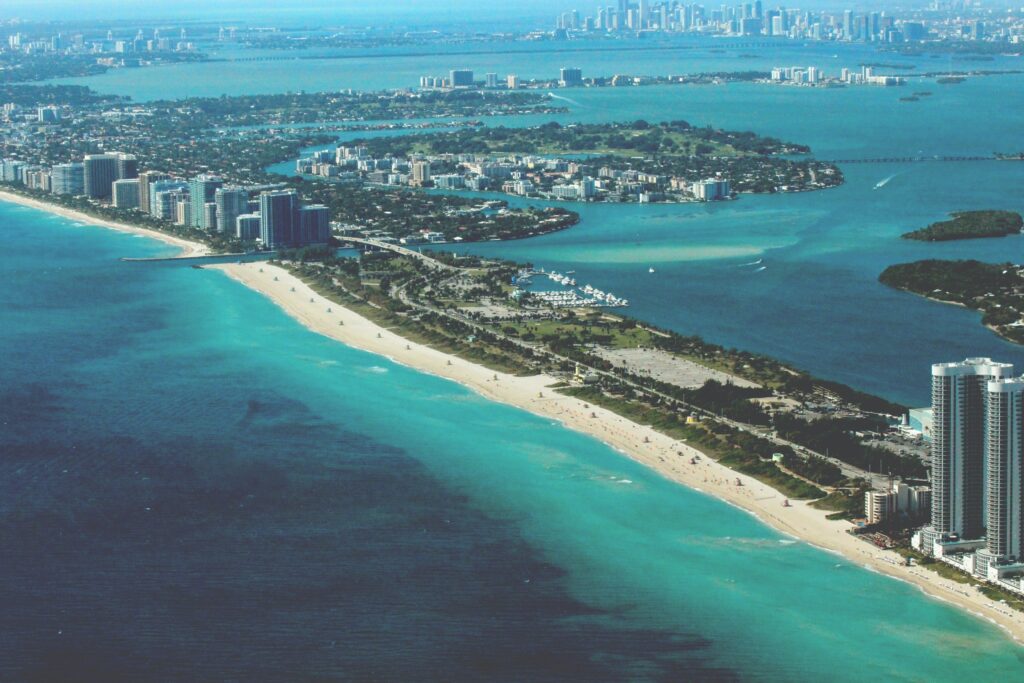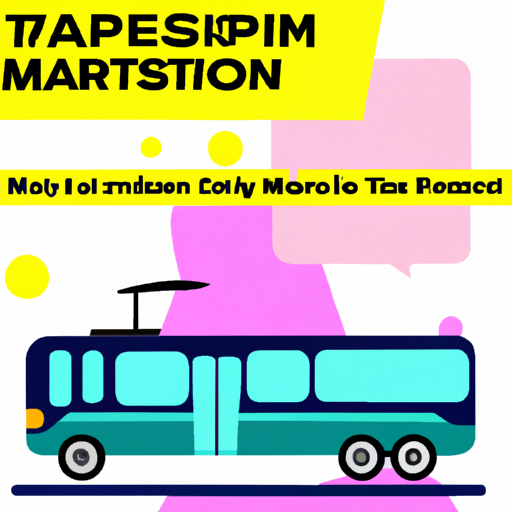You step onto the bustling streets of Miami, the sun glinting off the sleek glass towers and the sounds of lively conversation filling the air. As you take in the vibrant energy of this vibrant city, a question arises in your mind: How is public transportation in Miami? How does this iconic metropolis navigate its way from one corner to the other? In this article, we will delve into the world of Miami’s public transportation system, exploring its efficiency, accessibility, and the multitude of options available to residents and visitors alike.
From the iconic Art Deco District to the breathtaking beaches, Miami has much to offer, and exploring its diverse neighborhoods and cultural hotspots is made effortless with the city’s well-developed public transportation network. Whether you prefer hopping on a bus, taking the Metrorail, or riding the Metromover, Miami offers a range of options to suit your needs. Get ready to uncover the strengths and areas for improvement of public transportation in this vibrant city, and embark on an exciting journey to discover how Miami keeps its visitors and residents on the move. So let’s dive in and explore the ins and outs of public transportation in the Magic City! Miami boasts a comprehensive and efficient public transportation system that allows residents and visitors to travel conveniently and affordably throughout the city. With various modes of transportation and extensive coverage, getting around Miami has never been easier. In this article, we will provide an overview of the different types of public transportation, delve into the specifics of each mode of transportation, discuss costs and accessibility, and examine overall satisfaction and reliability.
Types of Public Transportation
Miami offers a diverse range of public transportation options to cater to the needs of its residents and visitors. These include Miami-Dade Transit, Miami Trolley, Tri-Rail, Metromover, Metrobus, and the Miami Beach Shuttle. Each mode of transportation has its own unique features and benefits, providing passengers with flexibility and convenience.
Costs of Public Transportation
The cost of using public transportation in Miami is generally affordable, making it an attractive option for many individuals. The fares for each mode of transportation vary, but they are designed to be accessible to people of all income levels. Additionally, there are different fare options available, such as single-ride tickets, day passes, and monthly passes, allowing passengers to choose the most cost-effective option based on their travel needs and frequency.
Accessibility of Public Transportation
Ensuring accessibility for all individuals is a top priority for Miami’s public transportation system. All modes of transportation are equipped with features to accommodate passengers with disabilities, including wheelchair ramps and priority seating. Additionally, stations and vehicles are designed to be easily navigable for individuals with mobility challenges. The commitment to accessibility makes public transportation in Miami inclusive and welcoming to everyone.

Miami-Dade Transit
Miami-Dade Transit is the backbone of public transportation in Miami and offers a wide range of services to suit different travel needs. It comprises several modes of transportation, namely Metrobus, Metrorail, Metromover, and the Miami Intermodal Center (MIC).
Metrobus
Metrobus is an extensive bus network that covers a vast area of Miami-Dade County. With over 90 routes and a fleet of modern buses, Metrobus provides reliable and convenient transportation to various destinations within the region. The routes are carefully planned to serve residential areas, commercial districts, and major attractions, ensuring that passengers can reach their desired destinations efficiently.
Metrorail
Metrorail is Miami’s rapid transit system, offering a reliable and efficient way to travel across the city. It consists of two lines – the Orange Line and the Green Line – which cover a significant portion of Miami-Dade County. Metrorail provides a faster alternative to road transportation, especially during peak hours, and is a popular choice for commuting to work or exploring different neighborhoods in the city.
Metromover
Metromover is a free automated people mover system that operates within downtown Miami and Brickell. It consists of three loops – the Inner Loop, the Outer Loop, and the Omni Loop – with each loop serving different areas of the city. Metromover is particularly popular among tourists and residents working in the downtown area, as it offers a convenient and cost-free means of transportation.
Miami Intermodal Center (MIC)
The Miami Intermodal Center (MIC) serves as a transportation hub that connects various modes of transportation, including Miami International Airport, Metrorail, and rental car facilities. It provides a seamless transition between different modes of transportation, making it incredibly convenient for travelers coming to or leaving Miami.
Miami Trolley
The Miami Trolley is a popular mode of transportation in Miami, known for its unique charm and widespread coverage. It operates a network of trolleys that serve different neighborhoods, providing free rides to passengers. The Miami Trolley is a great way to explore Miami’s diverse districts, from the lively streets of Wynwood to the glamorous South Beach.
Routes and Coverage
The Miami Trolley operates several routes that traverse various neighborhoods in Miami. The routes cover key areas of interest, such as downtown Miami, Miami Beach, Coconut Grove, and Coral Way. This extensive coverage allows passengers to reach their desired destinations conveniently and with ease.
Schedule and Frequency
The Miami Trolley operates on a fixed schedule, which is available on the official website and at each trolley stop. The trolleys run at regular intervals throughout the day, ensuring that passengers do not have to wait long for their ride. The frequency of service is designed to cater to both residents and tourists, providing a reliable and efficient means of transportation.
Fares and Payment
One of the standout features of the Miami Trolley is that it offers free rides to all passengers. There is no need to pay a fare or purchase a ticket, making it an affordable option for those on a tight budget. This free service has made the Miami Trolley a popular choice among both locals and visitors.
Accessibility Features
The Miami Trolley is designed to be accessible to all individuals, including those with mobility challenges. The trolleys are equipped with low floors and ramps, allowing passengers in wheelchairs or with strollers to board and alight with ease. Additionally, priority seating is available for passengers with disabilities, ensuring that everyone can travel comfortably and safely.
Tri-Rail
Tri-Rail is a commuter rail system that connects Miami-Dade, Broward, and Palm Beach counties, offering a convenient means of transportation for individuals commuting between these areas. It provides a cost-effective alternative to driving and alleviates congestion on the roads.
Routes and Destinations
Tri-Rail operates several routes that serve various destinations within Miami-Dade County, as well as neighboring counties. These routes connect major cities and employment hubs, making it easier for individuals to commute to work or explore different areas within the region.
Schedule and Frequency
Tri-Rail operates on a fixed schedule, which is available on its official website and at each station. Trains run at regular intervals throughout the day, ensuring that passengers can plan their journeys in advance. The frequency of service is designed to accommodate commuters and provide them with reliable transportation options.
Fares and Ticketing
Tri-Rail offers different fare options to cater to the diverse travel needs of its passengers. These include single-ride tickets, day passes, and monthly passes, allowing individuals to choose the most cost-effective option based on their frequency of travel. Tickets can be purchased at stations, online, or through Tri-Rail’s mobile app, making it convenient for passengers to obtain their tickets.
Connectivity with other Modes of Transportation
Tri-Rail offers seamless connectivity with other modes of transportation, allowing passengers to easily transfer between different modes of public transportation. Many Tri-Rail stations are located in close proximity to Metrobus and Metrorail stations, providing passengers with a hassle-free travel experience and allowing them to reach their final destinations conveniently.
Metromover
Metromover is a popular mode of transportation within downtown Miami, offering a free and efficient means of getting around. The elevated rail system operates on three loops, providing access to key destinations within the city center.
Routes and Stations
Metromover operates on three loops – the Inner Loop, the Outer Loop, and the Omni Loop. The Inner Loop serves the central business district of downtown Miami, connecting major office buildings, hotels, and shopping areas. The Outer Loop extends further to cover residential areas and cultural attractions, such as the Adrienne Arsht Center for the Performing Arts. The Omni Loop serves the Omni neighborhood and connects to key destinations, including the American Airlines Arena.
Operating Hours and Frequency
Metromover operates throughout the day, with service starting as early as 5:00 am and ending around midnight. Trains run at frequent intervals, typically every few minutes, ensuring that passengers do not have to wait long for their ride. The extended operating hours and high frequency of service make Metromover a reliable mode of transportation for both residents and visitors.
Free Service
One of the standout features of Metromover is that it offers free rides to all passengers. There is no need to pay a fare or purchase a ticket, making it an affordable option for daily commuting or exploring the downtown area. The free service has made Metromover a popular mode of transportation among locals and tourists alike.
Passenger Experience
Metromover provides a comfortable and enjoyable passenger experience. The trains are clean and well-maintained, and the elevated rail system offers scenic views of the city skyline. Additionally, the stations are equipped with amenities such as benches, ticket vending machines, and real-time arrival information, ensuring that passengers have a pleasant and stress-free journey.

Metrobus
Metrobus is a vital component of Miami’s public transportation system, offering extensive coverage and convenient transportation options to residents and visitors alike.
Routes and Coverage
Metrobus operates over 90 routes, covering a vast area of Miami-Dade County. The routes are carefully planned to serve residential areas, commercial districts, and major attractions. Whether you need to commute to work, run errands, or explore the city’s vibrant neighborhoods, there is likely a Metrobus route that can take you there.
Schedule and Frequency
Metrobus operates on a fixed schedule, which is available on the official website and at each bus stop. Buses run at regular intervals throughout the day, ensuring that passengers can plan their journeys in advance. The frequency of service varies depending on the route and time of day, but overall, Metrobus provides reliable transportation options.
Fares and Payment
To ride a Metrobus, passengers need to pay a fare or use a transit pass. Fares can be paid in cash directly to the bus operator or via contactless payment methods, such as the EASY Card or the EASY Ticket. The costs of fares vary depending on the type of ticket or pass purchased, with options available for single rides, day passes, and monthly passes.
Services and Amenities
Metrobus strives to provide a comfortable and convenient experience for its passengers. The buses are equipped with air conditioning, comfortable seating, and designated spaces for passengers with disabilities. Additionally, many buses offer free Wi-Fi, allowing passengers to stay connected during their journey. Metrobus also provides real-time bus arrival information, both online and at bus stops, ensuring that passengers are always informed about the status of their bus.
Metrorail
Metrorail is Miami’s rapid transit system, offering a reliable and efficient means of transportation across the city.
Routes and Stations
Metrorail consists of two lines – the Orange Line and the Green Line – which cover a significant portion of Miami-Dade County. The Orange Line runs from the Miami International Airport to the Dadeland South Station, while the Green Line runs from Palmetto to South Miami. The numerous stations along these lines provide passengers with easy access to key destinations, including residential areas, shopping centers, and employment hubs.
Operating Hours and Frequency
Metrorail operates throughout the day, with service starting as early as 5:00 am and ending around midnight. Trains run at regular intervals, typically every few minutes during peak hours and every 15 minutes during off-peak hours. The extended operating hours and high frequency of service ensure that passengers can rely on Metrorail for their daily commute or leisurely travel.
Fares and Payment
To ride Metrorail, passengers need to pay a fare or use a transit pass. Fares can be paid using the EASY Card, the EASY Ticket, or contactless payment methods such as Apple Pay or Google Pay. Like other modes of public transportation in Miami, the fares for Metrorail are designed to be accessible to people of all income levels, with options available for single rides, day passes, and monthly passes.
Accessibility Features
Metrorail is committed to providing an inclusive and accommodating environment for all passengers. All stations are equipped with elevators or escalators, ensuring that passengers with mobility challenges can access the platforms easily. Trains are designed with designated spaces for passengers with disabilities, as well as ramps for wheelchair access. The accessibility features of Metrorail make it a reliable and convenient mode of transportation for everyone.

Miami Beach Shuttle
The Miami Beach Shuttle is a convenient means of transportation for those looking to explore Miami Beach and its surrounding areas.
Routes and Destinations
The Miami Beach Shuttle operates several routes that cover various destinations within Miami Beach. These routes connect key areas of interest, such as South Beach, North Beach, and the Art Deco District. Whether you want to relax on the pristine beaches or explore the vibrant nightlife, the Miami Beach Shuttle provides a reliable and affordable way to get around.
Schedule and Frequency
The Miami Beach Shuttle operates on a fixed schedule, ensuring that passengers can plan their journeys in advance. The schedule is available at each shuttle stop, as well as on the official website. The shuttles run at regular intervals throughout the day, providing passengers with frequent service and minimising waiting times.
Fares and Payment
To ride the Miami Beach Shuttle, passengers need to pay a fare. The fares can be paid using cash or contactless payment methods, and the costs are affordable, making it an attractive transportation option for both locals and tourists. The Miami Beach Shuttle also offers day passes, allowing passengers to explore multiple destinations without having to pay for each individual ride.
Beach Access Points
One of the advantages of using the Miami Beach Shuttle is that it offers convenient access to the beach. The shuttle stops at various points along the Miami Beach coastline, allowing passengers to easily reach their desired beach access point. This makes it incredibly convenient for those looking to soak up the sun or enjoy water activities.
Overall Satisfaction and Reliability
Miami’s public transportation system has received positive feedback from users, largely due to its efficiency and reliability. Passengers appreciate the wide range of transport options available, as well as the connectivity between different modes of transportation. The punctuality and frequency of service have also been praised, with many users stating that they can rely on public transportation to reach their destinations in a timely manner.
Customer Feedback
Miami-Dade Transit actively seeks customer feedback to improve its services and address any concerns. Passengers are encouraged to provide feedback through the official website, social media platforms, or by contacting customer service representatives. This commitment to gathering customer feedback allows Miami-Dade Transit to make informed decisions and continuously enhance the quality of its services.
Efficiency and Punctuality
Efficiency and punctuality are key factors that contribute to the overall satisfaction of public transportation users in Miami. Regular commuters appreciate that the different modes of transportation adhere to fixed schedules, allowing them to plan their journeys accordingly. The high frequency of service helps minimize waiting times, ensuring a seamless and stress-free travel experience.
Maintenance and Upgrades
Miami-Dade Transit takes pride in maintaining its fleet of buses, trains, and trolleys to the highest standards. Regular maintenance checks and necessary repairs are carried out to ensure the safety and comfort of passengers. Furthermore, the transit authority continues to invest in upgrades and technological advancements to enhance the overall passenger experience and maintain the reliability of its services.
Future Development Plans
Miami-Dade Transit has ambitious plans for future development, aiming to improve connectivity, expand coverage, and reduce journey times. The authority intends to introduce new routes and modes of transportation, such as light rail systems and express bus services, to cater to growing demand and further enhance the public transportation network in Miami. These development plans align with the city’s vision of creating a sustainable and accessible transportation system.

Conclusion
In conclusion, public transportation in Miami offers a comprehensive and efficient means of getting around the city. With various modes of transportation, extensive coverage, and affordable fares, residents and visitors can explore Miami conveniently and economically. The commitment to accessibility ensures that public transportation is inclusive and welcoming to all individuals. While there are areas for improvement, such as enhancing connectivity between different modes of transportation and expanding coverage to underserved areas, Miami’s public transportation system continues to evolve and future development plans aim to address these concerns. Ultimately, public transportation in Miami provides a sustainable alternative to private vehicles, reducing congestion on the roads and contributing to a greener cityscape.





